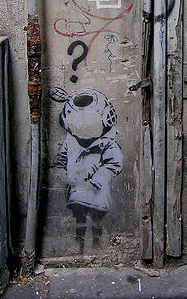Muddled over Banksy: Street Art in Melbourne
Muddled over Banksy: Street Art in Melbourne
 |
The bleary-eyed Adrian Doyle who makes the main speech is dreary in his efforts to be pretentious. ‘I am honoured to be here. I just got off a plane from Buenos Aires.’ Hyperbole was soon to follow, with a comment that the street art revolution in Melbourne was at least as great as the Aboriginal revolution of ‘over 30 years ago’. We are skating on supremely thin ice, and Doyle is happy to take his audience with him. Melbourne is one ‘enormous art space’, an observation that leaves little room for constructive discussion.
The veiled truth here is that graffiti has now become a statement of advertisement, an exchangeable commodity. Banksy would have disapproved, given his own words on the rationale of graffiti. ‘Advertising makes people feel inadequate and worthless,’ he claimed in a statement to Time magazine (Oct 29, 2008). Graffiti, on the other hand, never blackmailed, made people feel fat or made you ‘rush out and buy things, except maybe high strength cleaning products.’ That said, people are rushing out to purchase Banksy’s own products with feverish enthusiasm.
Melbourne’s relationship to Banksy is, in any case, a difficult one. The Melbourne Council inadvertently painted over one of his samples in the CBD earlier this year. The victim was a rat descending from a parachute, the handiwork of the anti-graffiti squad contracted to cleanse the inner city streets. That probably puts pay to the only Banksy that was left in the city, though others are bound to miraculously appear. What was notable was the reaction. Hugh Thorne of the Hosier Lane cocktail bar Misty Place summed it up. ‘It’s a shame, but no one really knew it was there. It was a quiet one’ (Melbourne Leader, Apr 27). The last of Banksy’s Melbourne casualties was a stencil featuring a diver adorning a trench coat on the corner of Swanston Street and Flinders Lane, the victim then, ironically, of vandals. Who, one might ask now, are the true vandals of the street scene?
Opinion is deeply divided, and such friction is probably something to be celebrated. Yes, a Banksy might have vanished before the city’s clean freaks, but the vandal is in all of us. ‘Trying to protect a Banksy piece is ridiculous,’ claimed one blogger on the Melbourne Leader site (Apr 27), ‘when there’s far more significant pieces from local artists who’s blood, sweat, tears and lives have been dedicated to making Melbourne more colourful and intern [sic] gentrifying suburbs in particular dirty laneways and bringing in tourists.’ Ironically, Banksy has been attacked as being a vandal himself. Not only is the jury out on this, but totally perplexed on where the parameters lie. Guerrilla warfare thrives on the street scene.
Graffiti art, as evidenced by such sanitising tributes as that held at the Metro, has entered the territory of the absurd. By its very anti-establishment, or more to the point, often illegal nature, it became a name. The culture critic from the Frankfurt School Theodor W. Adorno was wrong to have claimed that art is an uncommitted crime. In this case, the misdemeanour is purposely crafted, defiantly confronting. The vandals are daring Promethean practitioners. But in so doing, they created enemies within their movement, precisely because street art has a certain cannibalistic quality to it. Today’s vandal is tomorrow’s artist, and the principle works in reverse.
The sting of illegality is gradually being removed. City councils sense that there is money to be made from Banksy’s works. The graffiti artist is rapidly becoming the new agent for gentrification. Melbourne has introduced a permit system as a result. Building owners are entitled to display graffiti works. This, of course, creates that situation where ‘tagging’ and ‘street art’ is difficult to measure. But it also defeats the very purpose that such art was created in the first place. This is, after all, an art war. Had the building owner possessed the appropriate permit, Banksy’s parachuting rat would have survived. But would he really have wanted that? Perhaps, as the title of Asger Jorn’s oil canvas from 1962 goes, L’avant garde se rend pas – the avant-garde does not give up, even beyond the grave.
Binoy Kampmark was a Commonwealth Scholar at Selwyn College, Cambridge. He lectures at RMIT University, Melbourne. Email: bkampmark@gmail.com


 Binoy Kampmark: Bitter Harvests - The Gaza Ceasefire
Binoy Kampmark: Bitter Harvests - The Gaza Ceasefire Binoy Kampmark: Situation Critical - UNRWA And Its Continued Operations
Binoy Kampmark: Situation Critical - UNRWA And Its Continued Operations Martin LeFevre - Meditations: Waiting For Trump - How Bad Will It Be?
Martin LeFevre - Meditations: Waiting For Trump - How Bad Will It Be? Ramzy Baroud: The Gaza Genocide - The Fall Of Israel’s Immunity
Ramzy Baroud: The Gaza Genocide - The Fall Of Israel’s Immunity Gordon Campbell: On The History Of Doo Wop Music
Gordon Campbell: On The History Of Doo Wop Music Ian Powell: When Politics Gets In The Pocket Of The Gun Lobby
Ian Powell: When Politics Gets In The Pocket Of The Gun Lobby